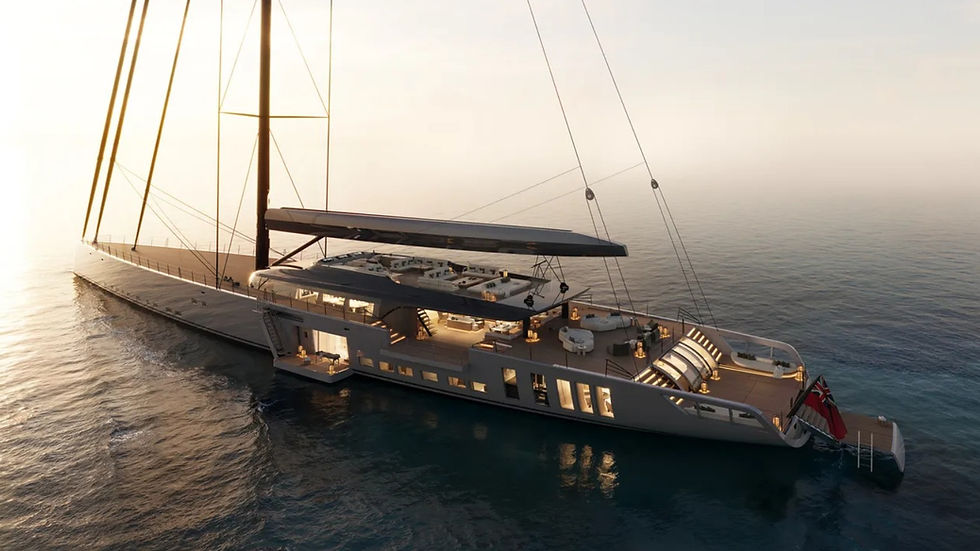Bill Gates' Hydrogen-Powered Superyacht is For Sale Immediately After Launching
- Scott Way

- May 9, 2024
- 3 min read
Updated: May 10, 2024

You'd think after commissioning one of the nicest superyachts on Earth you'd keep it for a minute.
The internet was abuzz this week when the freshly launched Feadship Project 821 was linked to almighty tech tycoon Bill Gates.
Not only is it yet another stunningly large vessel hitting the high seas, it's also the world's inaugural fuel cell-powered hydrogen vessel. It launched officially from Feadship's Royal Van Lent shipyard in Amsterdam on May 4th.
The 390 foot (118 m) ship harnesses liquid hydrogen stored at temperatures below -253° C (-423.4° F) to fuel its onboard electricity.
Number one, it's the first time in the world a superyacht has achieved complete hydrogen power and propulsion. Second, it marks a huge victory in the regulatory frameworks being developed to make hydrogen-powered boats more viable in the marine industry. And third, it's the largest superyacht ever launched out of The Netherlands.
“The aim has been to develop a new, clean technology not just for this project, but for the world,” Jan-Bart Verkuyl, Feadship director and CEO of Royal Van Lent, said in a press release.
Some of the keynote features of Project 821 include a semi-submerged 'Neptune' lounge, a library, a movie theater, medical facilities, and a massive swimming pool on the main deck. She also boasts five decks above the waterline, two decks below the waterline, fourteen balconies, and seven fold-out platforms to improve the view for guests.
The owner, whoever it is, will have it pretty sweet, too. The master suite features two full bedrooms, twin bathrooms, twin dressing rooms, a gym, a pantry, two offices with fireplaces, a living room, a library, a private dining room, and one of the ship's 14 balconies with its own Jacuzzi. It even has a private elevator.
In terms of power, Project 821 uses high-pressure fuel cells to generate electricity that feed her massive battery banks. The fuel cell converts hydrogen into electricity that is stored in lithium-ion batteries, with the only emission during the chemical reaction being water vapour. While the automotive industry is making huge inroads with hydrogen-power for road vehicles, the biggest obstacle to overcome for the marine industry, particularly the superyacht world, is how to store compressed liquid hydrogen at -423.4 degrees Fahrenheit in a manner that's reliable and safe.
According to Feadship, their R&D team has been researching hydrogen, among other fossil-free fuel options, as part of the company's pledge to develop "net zero" yachts by 2030. Although there have been hydrogen fuel cells in use for more than six decades, nothing has existed in the marine industry until now.
“We have now shown that cryogenic storage of liquified hydrogen in the interior of a superyacht is a viable solution,” said Verkuyl. “Future innovations on fuel cells and onboard reforming of methanol to hydrogen are on the near horizon.”
One of the most fascinating details is that hydrogen is extremely light, far lighter than diesel fuel, but it requires more space for operation. One cubic metre of liquid hydrogen weighs 70kg (154 lbs) versus 800kg (1764 lbs) per cubic metre of non-fossil diesel equivalent fuel (HVO or e-diesel). Despite the weight savings, safely storing hydrogen on a vessel requires a double-walled cryogenic storage tank (a large very well-insulated cooling box in a dedicated room). Together, it takes 8x to10x more space to store hydrogen than the energy equivalent in diesel fuel.
On Project 821, the cryogenic fuel tank that holds 92 m2 (4 tons) of hydrogen, the sixteen compact fuel cells, their switchboard connection to the DC electrical grid, and the vent stacks for the escaping water vapour added four metres to the yacht's original specification length. The fuel cells developed for Project 821 can also use easier-to-store methanol, a liquid fuel in ambient conditions. Steam reforms methanol into hydrogen before the electrochemical reaction in the fuel cell.
So why is a vessel as new, and as innovative, as Project 821 already up for sale?
Stories linking Gates to the vessel have been swirling for years. Outlets like the Telegraph reported that Gates commissioned a hydrogen-powered Feadship superyacht, designed by a company called Sinot, back in 2020. In typical superyacht secrecy, Sinot denied these claims, but reports have consistently linked Gates to Project 821. Details regarding how or why Gates' did not take possession of the boat have not been made public.
Whoever the original buyer was, for some reason they changed their mind. Project 821 is currently being offered for sale by Edmiston.
The price? You know what they say: 'if you have to ask...'. But according to several reports it was originally commissioned for around $640 million.
You can watch the launching of Project 821 in the video below:






















Comments